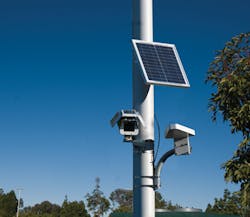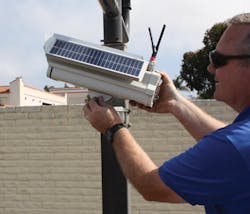| By using solar-powered cameras that can operate as long as five days on a single charge, energy costs can be dramatically reduced. |
Video surveillance can be a valuable tool to help water treatment providers ensure security of their assets and monitor operations in remote locations. Of course, there's more that goes into installing a surveillance system that can provide complete coverage of a water treatment facility's perimeter than simply deploying a few cameras on the exterior of a building and turning on the power. There are a multitude of factors that need to be considered, such as the size of the area that requires protection, the current security infrastructure, how power and network cabling can be extended to the perimeter's outer edges, bandwidth demands placed on the network by new cameras, and other areas of operation that may need to be monitored.
Perimeter Surveillance Approaches
Traditionally, installing a standard video surveillance system on a water treatment facility's perimeter required the use of conduit and cabling that ran to the cameras themselves. This process would cost thousands of dollars in addition to the investment already made in new security hardware. It would also take a significant amount of time to complete. However, advancements in technology, such as wireless communications and solar power, have made extending the reach of video quicker and more cost-effective for organizations to achieve.
In the past, wireless communications were somewhat unreliable, especially when transmitting video data back to a central monitoring location or recording appliance at the head-end. Many wireless devices could not consistently deliver reliable, high-quality footage for mission-critical applications. Now, wireless video has become the backbone of some of the most significant surveillance deployments in the industry and helps protect a range of assets from transit systems to large cities.
One of the most overlooked aspects of video surveillance installations is the cost of power consumption -- even to run a handful of cameras at the edge can cost an organization thousands of dollars over time. By using solar-powered cameras that can operate as long as five days on a single charge, however, those energy costs can be dramatically reduced. In the event of a power failure, a solar-powered camera can also ensure that the area under surveillance is still being actively monitored.
Given the capital investment saved upfront by not trenching and running cabling or power to perimeter cameras, a water treatment facility utilizing these combined technologies for its exterior video needs could install a system for as little as 15 percent of what it would cost to use a traditional approach. Additionally, a facility could also significantly reduce operational costs using solar-powered wireless cameras.
For example, an organization using 100 traditional cameras at the edge over a five-year period could save as much as $10,000 in energy costs by leveraging the sustainable energy provided by solar power. In an era where doing more with less has become the mantra for organizations in both the public and private sectors, the feasibility of using solar and wireless technologies for outdoor surveillance applications deserves serious consideration.
Getting Stakeholder Buy-In
The cost of perimeter surveillance is always the steepest in any security project, regardless of the application. In some cases, organizations abandon their perimeter video plans altogether because the cost per camera becomes unwieldy. As an alternative, facilities will often mount high-resolution megapixel cameras on the side of a building, but their visibility is reduced at approximately 300 feet because the light is minimal at that range.
Extending video surveillance at the perimeter and transmitting the video back to a central command center is much more cost-effective than installing lighting at the edge or waiting weeks or months to receive permitting for trenching and cable runs.
The challenge then becomes convincing stakeholders in the organization to make the necessary investments to improve perimeter surveillance capabilities. The solution is to show them the return-on-investment (ROI) that can be realized by deploying wireless, solar-powered cameras -- not just in terms of the enhanced security they can provide but also the cost savings and operational benefits that can be achieved.
The ROI could be in the form of reduced manpower needed to secure a facility. For example, if a water treatment facility currently has five security officers patrolling the perimeter of the property 24/7, then installing a four- to six-camera video system on the premises could potentially replace two guards. Not only would there be cost savings as a result of the reduction in staff but there would also be a force multiplier and improvement in coverage with the camera installations.




